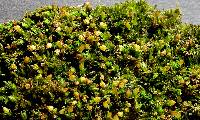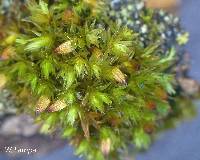
|
|
|
|
Family: Orthotrichaceae
orthotrichum moss
[Dorcadion pumilum (Sw.) Lindb., moreDorcadion schimperi (Hammar) Lindb., Orthotrichum affine var. fallax (Bruch ex Brid.) Hampe, Orthotrichum brachytrichum Schimp. ex Lesq. & James, Orthotrichum fallax Bruch ex Brid., Orthotrichum kaurinii Gronvall, Orthotrichum pumilum subsp. fallax (Bruch ex Brid.) Bertsch, Orthotrichum pumilum subsp. pumilum , Orthotrichum pumilum var. fallax (Bruch) Bertsch, Orthotrichum pumilum var. pumilum , Orthotrichum pumilum var. schimperi (Hammar) Hinn., Orthotrichum schimperi Hammar, Orthotrichum tenellum var. pumilum (Sw.) Boulay] |
The following is from the California Moss eFlora. See here Plants erect in small green to rather dark green tufts, to 5 mm high. Leaves spreading when moist but, when dry, loosely erect with apices not incurved. Leaves to 2.5 mm long, about 3: 1, ovate-lanceolate to lanceolate with obtuse to rounded but minutely apiculate apices. Median laminal cells isodiametric with rounded lumens, thick walled with strong corner thickening, to 18 µm wide, smooth or with 1–2 very low papillae on both surfaces. Basal juxtacostal cells pellucid and rectangular, 1.5–2.5:1, to 24 µm wide with lateral walls straight but somewhat unevenly thickened. Basal juxtamarginal cells isodiametric and similar to median laminal cells. Margins recurved from base to near the apex, entire or with a few serrulations at the extreme apex. Costa ending within about ten cells of apex, not situated in a keel. Costa cross-section homogeneous, at mid-leaf only 2 cells thick and up to 4 cells wide. Axillary hairs mostly rather uniform in size, to 5 cells and 100 µm long, with one basal brown cell, not offset from leaf insertion. Rhizoids abundant near base of plant but also present even on distal portions of plant, smooth, pale-brown to red-brown, to 30 µm in diameter at base, sparingly branched. Stem cross-section without a central strand, with hyaline inner corticals and with 1–2 layers of somewhat thicker-walled, red brown outer cortical cells. Gemmae scattered on adaxial leaf surface, to 25 µm in diameter, composed of 3–4 essentially isodiametric, green cells Conrad, H., & Redfearn, Jr., P. (1979). How to know the mosses and liverworts. (2nd ed.). Dubuque, Iowa: Wm. C. Brown Company Publishers. Crum, H. (1983). Mosses of the Great Lakes forests. (3rd ed.). Ann Arbor, Michigan: University of Michigan Herbarium. Crum, H. A., & Anderson, L. E. (1981). Mosses of eastern North America. (Vol. 2). NY, New York: Columbia University Press. Plants: to 0.5 cm. Stem: leaves stiff, loosely erect-appressed when dry, ovate-lanceolate to lanceolate, 1.8–2.8 mm; margins revolute nearly to apex, entire; apex sharply to slenderly acute, usually apiculate, rarely obtuse, not carinate, not incurved when dry; basal laminal cells rectangular, grading to quadrate at margin, walls thin, not nodose; distal cells 14–20 µm, 1-stratose, lumina smooth, rounded, smooth or papillae 1 or 2 per cell, conic, small. : Specialized asexual reproduction occasional, by gemmae on leaves. Sexual: condition autoicous. Vaginula: with hairs absent. Seta: to 0.5 mm. Capsule: immersed to 3/4 emergent, oblong to oblong-cylindric, 1.2–1.5 mm, strongly 8-ribbed, sometimes constricted below mouth when dry; stomata immersed, mid capsule, not or to 1/2 covered by subsidiary cells, cells projecting or not, inner walls thickened or not; peristome double; prostome absent; exostome teeth 8, rarely splitting to 16, reflexed, finely and evenly papillose; endostome segments 8, not well developed, of 1 or 2 rows of cells, smooth. Calyptra: oblong, smooth, sparsely hairy or rarely naked, hairs smooth. Spores: 14–21 µm. Trunks, lower branches, base of deciduous trees, coniferous trees, crevices of rock, open, hardwood forests, trees along roadsides. low to moderate elevations (10-1000 m). Alta., Man., Ont., Sask., Ariz., Calif., Colo., D.C., Idaho, Ill., Iowa, Kans., Md., Mass., Mich., Minn., Miss., Mo., Mont., Nebr., N.H., N.J., N.Mex., N.Y., N.Dak., Ohio, Okla., Pa., S.C., S.Dak., Tenn., Tex., Utah, Vt., Va., Wash., W.Va., Wis., Europe, n Africa. Orthotrichum pumilum usually can be distinguished by the strongly ribbed capsules, reflexed peristome teeth, apiculate leaves with cells larger than 14 µm, and papillae that are very small or absent. In eastern North America, this taxon is uniform and non-variable, but in the West it is much more variable. Many western specimens have capsules that are oblong-cylindric, often strangulate, over 1/2 emergent, and gradually contracted to the seta. |
|
|
|





































































































